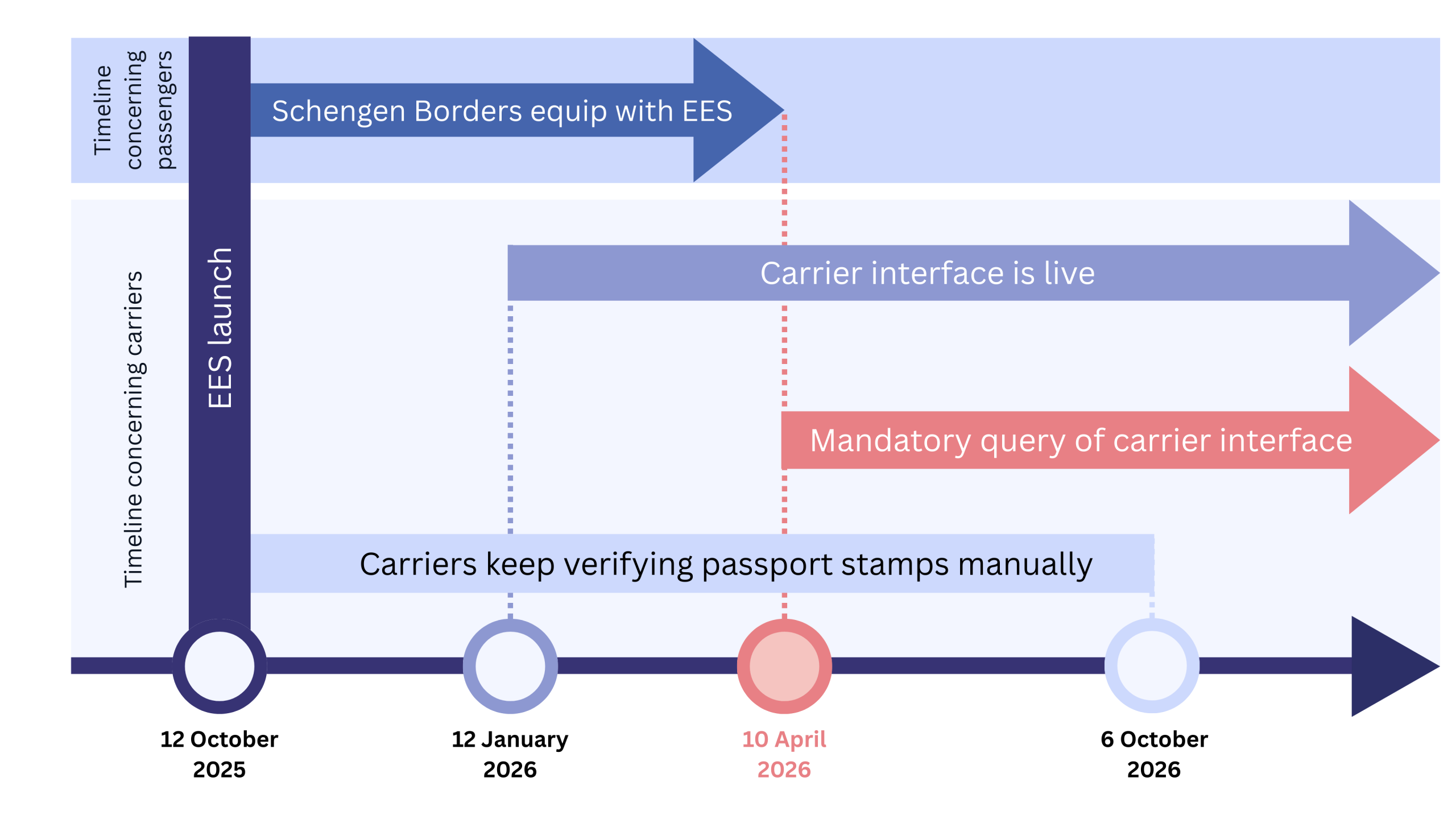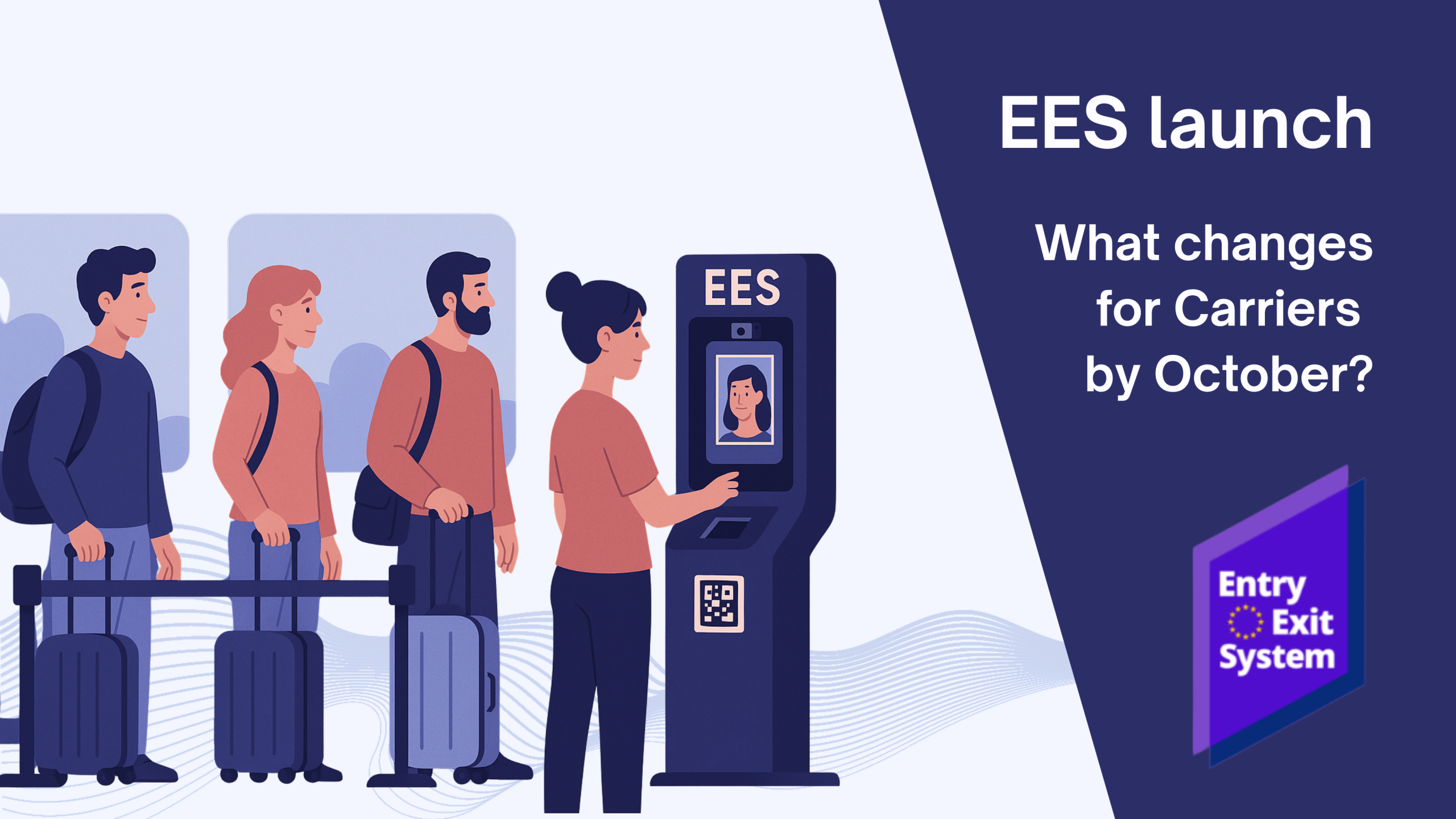After some delays, the Entry/Exit System (EES) is on the horizon. The official rollout begins on October 12th, 2025, with full enforcement starting April 10th, 2026. While certain passengers will experience a shift in how they cross European borders, operators and carriers will also face new ways to check passenger documents. In this article, we’ll look at what the EES means for passengers and operators, outline the key rollout dates, and explain how carriers can stay compliant at each stage.
A Quick Recap: What is the EES?
The Entry/Exit System (EES) is an IT system deployed at the EU and Schengen level and managed by the eu-LISA agency. Its primary goal is to replace manual passport stamping with a digital and automated solution that strengthens border management.
In practice, the EES will record the entry and exit of non-EU and non-Schengen nationals traveling for short stays, defined as up to 90 days within any 180-day period. Each time these travelers cross an external Schengen border, their data will be recorded electronically rather than through a physical stamp.
For a deeper dive into the role of eu-LISA and EES, you can explore our detailed article.
What Does it Mean for Passengers?
For travelers, the change is straightforward: instead of relying on stamps, the system collects data digitally. This includes information from the travel document as well as biometric identifiers.
- Short-stay visa holders: Their fingerprints are already captured at the time of applying for a visa, so EES will only store a facial image.
- Visa-exempt travelers: They will need to provide both a facial image and four fingerprints upon first entry.
- Children under 12: Currently exempt from fingerprint collection, though their data will still be registered in the system.
What Does it Mean for Carriers?
For carriers, the impact is more operational. Airlines and operators are legally required to verify that all passengers hold valid permission to travel. With the introduction of EES, this responsibility takes on a digital dimension.
Carriers must query a new eu-LISA carrier interface before boarding to check if non-EU passengers with visas have already used their permitted number of entries. This step helps prevent unauthorized travel and ensures compliance with EU regulations.
What is the Immediate Impact for Carriers by October 12, 2025?
From October 12 until January 12, 2026: EES will only impact non-EU/Schengen passengers and only when on a flight entering the Schengen/EU area.
There is no impact for carriers. Nevertheless, we advise you to inform affected passengers about the new border-crossing process.
Carrier Requirements at Each Rollout Stage
October 12, 2025: The EES rollout begins. Collection of biometric data of non-Schengen/non-EU passengers at border crossing points starts — this process will be progressively rolled out to cover all the external borders by April 9, 2026.
January 12, 2026: The eu-LISA carrier interface becomes available. We advise operators to opt for voluntary queries during this phase in order to test the system and receive training. We will activate our service and connect our clients on request.
April 10, 2026: The EES goes live in full. From this date, carrier queries become mandatory. Operators must get confirmation of travel permissions before boarding through the eu-LISA carrier interface.
Until October 6, 2026: Carriers must continue manual stamp verification alongside EES queries, ensuring a transition period where both systems operate in parallel. Some entries may still be recorded by passport stamps.

Key Takeaways for Carriers
As of the rollout start on October 12th, 2025, there are no new obligations for carriers. This stage is focused on preparing Schengen border points to be equipped with Entry/Exit Systems. The EES will be fully deployed and effective on April 10th, 2026, at which point carriers will be required to query the system for non-EU nationals.
To ensure compliance, we recommend making use of the voluntary phase beginning on January 10th, 2026. This period allows carriers to test the interface, become familiar with queries, and prepare for full implementation.
Automating EES Checks with Streamlane
With Streamlane, EES checks become simple, reliable, and stress-free. As a eu-LISA certified provider, Streamlane connects directly and securely to the eu-LISA database, ensuring every query is safe and compliant.
Operators receive real-time EES statuses straight within their flight management system or via our easy-to-use web portal. Each status comes with clear messages, guiding operational actions so that teams know exactly what to do.
The process is designed for efficiency: operators can query the EES at any time, well ahead of departure. There’s no platform switching, no wasted time on manual data entry, and no risk of spelling errors or duplicate entries. Instead, operators gain peace of mind, knowing they are fully prepared in advance—without last-minute surprises or added stress.
FAQ
Which countries impose EES checks?
Austria, Belgium, Bulgaria, Croatia, Czechia, Denmark, Estonia, Finland, France, Germany, Greece, Hungary, Iceland, Italy, Latvia, Liechtenstein, Lithuania, Luxembourg, Malta, Netherlands, Norway, Poland, Portugal, Romania, Slovakia, Slovenia, Spain, Sweden, Switzerland.
